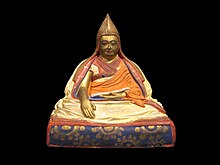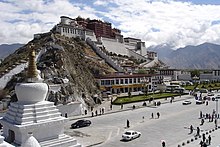Ngawang Lobsang Gyatsho
| Tibetan name |
|---|
|
Tibetan script :
བློ་ བཟང་ རྒྱ་མཚོ་
|
|
Wylie transliteration : ngag dbang blo bzang rgya mtsho
|
|
Pronunciation in IPA : [
lɔsaŋ catsʰɔ ]
|
|
Official transcription of the PRCh : Losang Gyaco
|
|
THDL transcription : Losang Gyatso
|
|
Other spellings: Lobsang Gyatsho, Lobsang Gyatso, Lobzang Gyatso, Lopsang Gyatso, Lozang Gyatso
|
| Chinese name |
|
Traditional :
羅桑 嘉措
|
|
Simplified :
罗桑 嘉措
|
|
Pinyin : Luōsāng Jiācuò
|
Ngawang Lobsang Gyatsho ( 1617 - 1682 ) was the 5th Dalai Lama of Tibet and, in addition to his religious significance within the Gelug School, was also an able statesman.
Ruler of Tibet
At the time of the political decline of the Phagmodru government in Tibet, the 5th Dalai Lama secured the political supremacy of the Gelug school through an alliance with the Mongol Gushri Khan , the leader of the Khoshuud . Gushri Khan put down a revolt of the king of Tsang Tenkyong Wangpo (1606–1642), a follower of the 10th Karmapa , militarily and secured the Dalai Lama on May 3, 1642 secular power over Tibet. The Karma Kagyu School involved in the conflict was severely persecuted in Tsang province. The Jonangpa school was also persecuted and banned as heretical by the 5th Dalai Lama in the central provinces of Tibet . Officially, this happened because of a wrong philosophical view of "emptiness" ( Shunyata ), one of the cornerstones of Buddhist teaching, but political reasons may also play a role. In 1653 the 5th Dalai Lama visited Beijing , the capital of the Qing Dynasty . Emperor Shunzhi granted him an audience on February 9. In the audience hall, Ngawang Lobsang Gyatsho sat on a throne to the right of the almost 15-year-old emperor. This awarded him the title “Outstanding, self-existing Buddha of the West” as well as a gold official seal and gave him an album made of gold. In return, the Dalai Lama awarded the emperor the title "Great Master, Most High, God of Heaven and Bodhisattva " on a gold plaque .
Eminent spiritual teacher of various traditions
The 5th Dalai Lama was not only an important Gelug lineage holder and an able statesman, but also lineage holder of some Nyingma transmissions, especially that of the " Northern Treasures " and Tertön. Tertöns are "treasure hunters" of hidden teachings, ritual objects and relics that Padmasambhava - the founder of the Nyingma - and his closest disciples had hidden in the 9th century. Of the “treasure teachings” ( Terma ) of the 5th Dalai Lama, especially the Dzogchen teachings from a revelation in pure vision by Gyachen Nyer Nga (“twenty-five sealed teachings”) are known. Also known is the empowerment of Padmasambhava and his eight manifestations, which according to legend he received as a vision directly from Padmasambhava. At the behest of the 5th Dalai Lama, some of his disciples founded various monasteries of the Nyingma tradition in the Tibetan province of Kham .
Potala Palace and Nechung Monastery
In 1645 the construction of the Potala Palace began , which was not completed until 1693, after the death of the "great fifth".
The Nechung Monastery was built around the same time that, according to a legend, the deity Pekar , formerly the main patron deity of the Samye Monastery, went to Nechung, where she has been known as the "Nechung Oracle" and the "State Oracle of the Tibetan Government" since that time seems to reveal.
Awarded the title of Penchen Lama
As an important spiritual representative of the Gelugpa, his teacher Lobsang Chökyi Gyeltshen (1570–1662) was awarded the title “ Penchen Lama ”. Since then, the Penchen Lama has been the second highest trülku within the hierarchy of the Gelug order, although he is seen as the incarnation of Amitabha - that is, as the spiritual "foster father" of Avalokiteshvara .
literature
- Dalai Lama: Dzogchen - The Heart-Essence of Great Perfection . Theseus, Berlin 2001, ISBN 3-89620-171-9 .
- The fifth Dalai Lama: Practice of Emptiness - The Perfection of Wisdom Chapter of the Fifth Dalai Lamas's “Sacred Word of Manjushri” . Library of Tibetan Works and Archives, Dharamsala 1974.
- The fifth Dalai Lama: Sacred Word of Manjushri , Library of Tibetan Works and Archives, Dharamsala 1974.
- Günther Schulemann : The History of the Dalai Lamas. Leipzig 1958, DNB 454503199 .
- Andreas Gruschke: Diederichs compact - Dalai Lama . Kreuzlingen / Munich 2003, ISBN 3-7205-2461-2 .
- Martin Brauen (Ed.): The Dalai Lamas . Ethnographic Museum of the University of Zurich , 2005, ISBN 3-89790-219-2 .
- Karmay / Samten Gyaltsen, The Secret Visions of the Fifth Dalai Lama . Serindia Press, bremen.de .
- Karl-Heinz Golzio, Pietro Bandini: The fourteen rebirths of the Dalai Lama. The rulers of Tibet - how they come back, how they are found, what they have left behind. OW Barth, Bern a. a. 1997, ISBN 3-502-61002-9 .
Web links
- Literature by and about Ngawang Lobsang Gyatsho in the catalog of the German National Library
- The Fifth Dalai Lama and his Reunification of Tibet - Samten G. Karmay
- The Fifth Dalai Lama, Ngawang Lobzang Gyatso - Alexander Gardner
- himalayanart.org: Teacher: Dalai Lama V, Lobzang Gyatso
- ngag dbang blo bzang rgya mtsho
Individual evidence
- ↑ 西天 大 善 自在 佛所 領 天下 釋 教 普通 瓦 赤 喇 怛 達賴喇嘛 / ནུབ་ཕྱོགས་ ཕུལ་ བྱུང་ ཞི་ བ་ སངས་ རྒྱས་ རྒྱ་ རྒྱ་ ཆེན་ ཁྱོན་ ལ་ སངས་ རྒྱས་ བསྟན་ པའི ་ མངའ་ བདག་ ཐམས་ཅད་ མཁྱེན་པ་ རྡོ་ རྗེ་ འཆང་ ཏཱ་ ལའི་ བླ་ མ །
- ↑ snowlionpub.com: Dzogchen (English; PDF file; 146 kB)
| personal data | |
|---|---|
| SURNAME | Ngawang Lobsang Gyatsho |
| ALTERNATIVE NAMES | ngag dbang blo bzang rgya mtsho |
| BRIEF DESCRIPTION | fifth Dalai Lama |
| DATE OF BIRTH | 1617 |
| DATE OF DEATH | 1682 |


